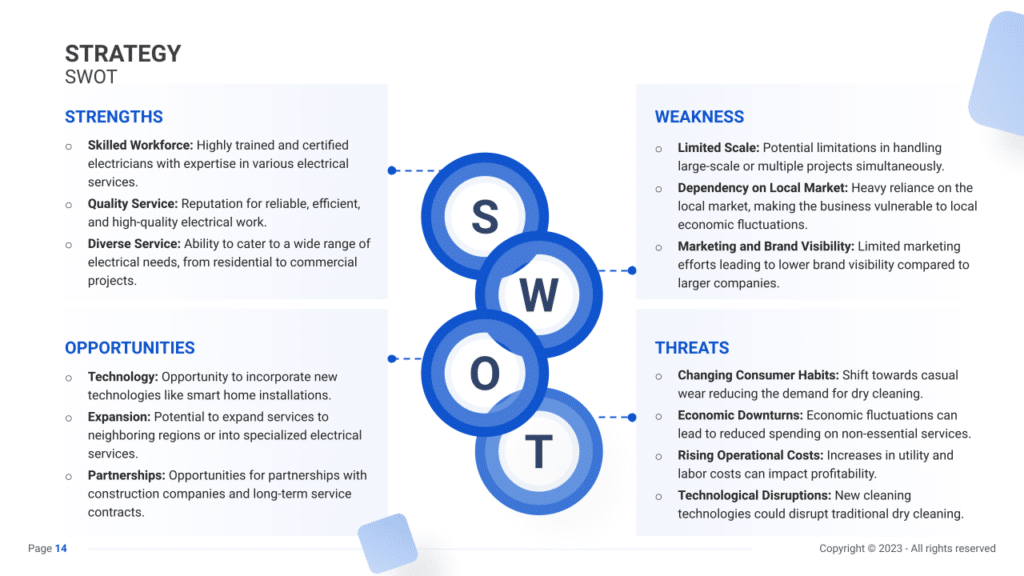Electrician Business Plan Template & PDF Example

Creating a comprehensive business plan is crucial for launching and running a successful electrician service. This plan serves as your roadmap, detailing your vision, operational strategies, and financial plan. It helps establish your electrician service’s identity, navigate the competitive market, and secure funding for growth.
This article not only breaks down the critical components of an electrician service business plan, but also provides an example of a business plan to help you craft your own.
Whether you’re an experienced entrepreneur or new to the service industry, this guide, complete with a business plan example, lays the groundwork for turning your electrician service concept into reality. Let’s dive in!
The Plan
Our Electrician Business Plan is strategically crafted to encapsulate all crucial elements necessary for a comprehensive approach. It delineates the company’s operations, market strategies, competitive landscape, team management, and financial forecasts.
- Executive Summary: Offers a snapshot of the electrician business, underscoring the array of electrical services for residential, commercial, and industrial clients, market insights, management expertise, and financial strategy.
- Business Overview: Sheds light on the services and pricing structure, emphasizing:
- Services & Prices: Enumerates a wide range of electrical services, including installations, maintenance, emergency services, energy-efficient solutions, and safety inspections, complemented by a transparent pricing model.
- Market Overview: Provides an in-depth analysis of the electrical services sector, highlighting:
- Key Stats: Details the market size, growth trends, and electrician demographics in the U.S.
- Key Trends: Discusses the growing demand for smart home technologies, renewable energy integration, LED retrofitting, and the evolving regulatory landscape.
- Key Competitors: Reviews major competitors, assessing their service offerings and market stance.
- Differentiation: Illustrates the unique selling propositions such as tailored electrical solutions, focus on energy efficiency, advanced technological applications, competitive pricing, and a robust online presence.
- Strategy: Outlines the strategic plan for growth and market engagement, featuring:
- SWOT Analysis: Conducts a comprehensive analysis of strengths, weaknesses, opportunities, and threats.
- Marketing Plan: Crafts strategies for outreach and client acquisition, leveraging digital platforms, content marketing, community engagement, and strategic partnerships.
- Timeline: Sets forth pivotal milestones and objectives for the business’s developmental phases and market penetration.
- Management: Introduces the leadership team, accentuating their extensive experience in electrical services and business management, underscoring their roles in steering the company towards its goals.
- Financial Plan: Forecasts the financial trajectory, outlining revenue targets, profit margins, and essential financial metrics, underpinned by assumptions regarding service contracts, pricing strategy, and customer loyalty. Discusses funding initiatives to fuel startup and expansion phases.

Executive Summary
The Executive Summary introduces your electrician business’s business plan, offering a concise overview of your company and its services. It should detail your market positioning, the range of electrical services you offer, including installations, maintenance, and repairs, its location, size, and an outline of day-to-day operations.
This section should also explore how your electrician business will integrate into the local market, including the number of direct competitors within the area, identifying who they are, along with your business’s unique selling points that differentiate it from these competitors.
Furthermore, you should include information about the management and co-founding team, detailing their roles and contributions to the business’s success. Additionally, a summary of your financial projections, including revenue and profits over the next five years, should be presented here to provide a clear picture of your business’s financial plan.
Electrician Business Plan Executive Summary Example


Business Overview
In the business overview section of an executive summary, the focus is on presenting a clear picture of the company’s operational model, services offered, and any unique aspects that distinguish the business from its competitors.
This section is crucial as it conveys to investors and partners what the business does, how it operates, and what makes it special. It should include details such as the range of services, location, operational hours, and any specialized offerings.
For a service-based business like an electrician service, this section would also highlight qualifications, certifications, and specific areas of expertise. The goal is to succinctly inform stakeholders about the core aspects of the business, setting the stage for understanding its place in the market.
Example:
For a company like Electricity Plus, the business overview would detail its comprehensive range of electrical services, its strategic location for efficient service delivery, and its commitment to using advanced technology and eco-friendly solutions. This overview would emphasize the company’s ability to meet diverse electrical needs, from routine maintenance to emergency repairs.
Market Overview
The market analysis section of an executive summary provides an overview of the industry in which the business operates. It should include information about the market size, growth rate, key trends, and competitive landscape.
This section is important because it gives context to the business’s operational environment, showing how the company fits within the broader industry.
It should identify the primary drivers of demand in the market, any regulatory considerations, and how the business is positioned relative to its competitors. For investors and partners, this section helps assess the market opportunity and the company’s potential to capture market share.
Example:
In the case of Electricity Plus, the market analysis would cover the size and growth rate of the U.S. electrical services market, highlighting trends such as the increasing demand for smart and energy-efficient solutions. It would also address the competitive landscape, showing how Electricity Plus stands out with its specialized services and technological expertise.
Management Team
This section of the executive summary outlines the composition and background of the management team, emphasizing their relevant experience and skills.
It’s crucial because the capabilities and track record of the management team are often key determinants of a business’s potential for success.
This section should highlight each member’s industry experience, areas of expertise, and their roles within the company. For investors and partners, understanding who is behind the business and their qualifications can provide confidence in the company’s ability to execute its business plan.
Example:
For Electricity Plus, this section would focus on the credentials and experience of the CEO and COO, detailing their backgrounds in electrical work and business operations. It would highlight their complementary skills in project management, customer relations, and strategic business development.
Financial Plan
The financial plan overview in an executive summary presents the key financial targets and objectives of the business, such as revenue goals and profit margins.
This section is important as it provides a snapshot of the financial health and ambitions of the company. It should give a clear picture of the expected financial performance over a specific period, including any significant financial strategies or initiatives. For stakeholders, this section helps assess the viability and profitability of the business, as well as the feasibility of the financial projections.
Example:
In Electricity Plus’s financial plan overview, the focus would be on achieving specific revenue and profit margin targets by a certain year. This would include their strategies for growth, such as expanding service offerings or targeting new market segments, and how these strategies are expected to impact financial performance.
Business Overview
Services & Fees
Briefly describe your electrician business’s service offerings, emphasizing the breadth and quality of electrical services provided, including residential and commercial installations, maintenance, and emergency repairs.
Mention your business’s location, highlighting its strategic positioning to serve a broad area effectively, the ease of accessibility for your teams to reach clients and any logistical advantages it provides. Explain why this location is beneficial in ensuring prompt and efficient service, which is crucial in emergency electrical situations.

Market Overview

Industry Size & Growth
Analyze the electrical services industry’s size and its potential for growth, focusing on opportunities in residential and commercial sectors due to new constructions, renovations, and the shift towards energy efficiency and smart technologies.
Key Market Trends
Highlight the trend towards energy-efficient solutions, the integration of smart home systems, and the increasing need for reliable electrical maintenance. Emphasize the rising demand for electric vehicle charging installations.
Competitive Landscape
A competitive analysis is not just a tool for gauging the position of your electrician business in the market and its key competitors; it’s also a fundamental component of your business plan.
This analysis helps identify your electrician business’s unique selling points, which are essential for differentiating your business in a competitive market.
In addition, competitive analysis is integral in laying a solid foundation for your business plan. By examining various operational aspects of your competitors, you gain valuable information that ensures your business plan is robust, informed, and tailored to succeed in the current market environment.
Identifying Your Competitors in the Electrical Services Industry
The first phase of the analysis involves pinpointing direct and indirect competitors in the local market. Direct competitors might include other local electricians, electrical contracting firms, or companies specializing in specific electrical services such as home automation or solar panel installations. Indirect competitors could be handymen offering electrical services or larger companies that provide a range of home maintenance solutions.
Utilizing tools like Google Maps can assist in mapping out the geographic distribution of competitors. Online platforms like Angie’s List or HomeAdvisor can provide customer reviews and ratings, offering valuable insights into competitors’ strengths and weaknesses. For instance, if “Bright Sparks Electrical” receives high praise for prompt service and expertise in rewiring homes, this indicates a significant strength to consider.

Electrician Business Competitors’ Strategies
Analyzing competitors’ strategies involves a multi-faceted approach:
- Service Offerings: Evaluate the range of services provided by competitors. For instance, if “EcoTech Electrical” emphasizes eco-friendly electrical solutions like energy-efficient lighting or sustainable wiring, it signifies a market trend toward environmentally conscious services.
- Technological Adaptation: Consider the integration of technology in service delivery. An electrician firm like “SmartWired Solutions” might specialize in smart home installations, catering to a distinct customer segment compared to traditional electricians.
- Pricing Models: Compare pricing structures with competitors. Are your rates aligned with those of “ValueVolt Electric,” or do they mirror the premium pricing strategies of “Precision Power Services”?
- Marketing Approaches: Assess how competitors market their services. Do they leverage digital marketing channels effectively or rely more on traditional advertising methods?
- Customer Experience: Analyze the customer experience provided by competitors. For example, “Swift Sparks Electric” might be known for exceptional after-service support and a user-friendly appointment scheduling system, contributing to a positive customer experience.
- Operational Efficiency: Observe competitors’ operational strategies. Are there innovative processes, like efficient scheduling systems or transparent pricing models, that distinguish them in the market?
What’s Your Electrician Business’s Value Proposition?
Reflect on your electrician business’s unique value proposition. Perhaps your company specializes in emergency services, providing 24/7 support, or maybe it focuses on commercial electrical maintenance for local businesses.
Identify gaps in the market through client feedback and industry trends. For instance, with the increasing demand for energy-efficient solutions, there might be an opportunity to introduce specialized energy audits or green technology installations if competitors are not addressing this need.
Consider your location: An electrician business situated in an area with older homes might emphasize expertise in historical electrical systems, while one in a tech-savvy neighborhood could highlight proficiency in smart home installations.
Strategy

SWOT
First, conduct a SWOT analysis for the electrician business, highlighting Strengths (such as certified expertise and a broad range of electrical services), Weaknesses (including market saturation or limited brand recognition), Opportunities (for example, the growing demand for smart home installations and renewable energy solutions), and Threats (such as regulatory changes or economic downturns that may impact construction and renovation projects).

Marketing Plan
Next, develop a marketing strategy that outlines how to attract and retain clients through targeted advertising, promotional offers, a strong online presence, and participation in local community events.
Marketing Channels
Leveraging diverse marketing channels amplifies your reach and engagement with potential clients.
Digital Marketing
- Optimize Online Presence: Ensure your website is not just informative but also user-friendly and mobile-responsive. Implement search engine optimization (SEO) strategies to improve visibility in local search results for electrical services.
- Social Media Engagement: Engage with your audience by sharing informative content, safety tips, project showcases, and client testimonials on platforms like Facebook, Instagram, LinkedIn, and Twitter. Encourage interactions and respond promptly to inquiries or comments.
- Email Marketing: Develop an email list through your website or networking events. Send regular newsletters with valuable content, industry updates, and exclusive offers to keep your audience engaged.
Local Advertising
- Direct Community Engagement: Apart from online efforts, invest in local directories, business listings, and community-specific publications. Sponsor local events or participate in neighborhood initiatives to foster a stronger local presence.
- Educational Workshops: Offer free workshops or seminars on electrical safety, energy-saving tips, or smart home technology in collaboration with community centers or local organizations. This not only showcases expertise but also builds trust among potential customers.
Promotional Activities
Incorporate attractive promotional strategies to capture the attention of potential clients.
- Seasonal Deals: Introduce seasonal promotions like discounted safety inspections before winter storms or special rates for lighting upgrades during the festive season.
- Referral Programs: Incentivize your existing client base to refer friends, family, or colleagues by offering discounts or additional services for successful referrals. Word-of-mouth remains a potent marketing tool in the service industry.

Sales Channels
Implementing effective sales strategies ensures not just customer acquisition but also long-term satisfaction and loyalty.
Client Engagement During Service
- Upselling Opportunities: While conducting electrical repairs or installations, recommend additional services or upgrades that enhance safety, efficiency, or convenience. For instance, suggest surge protectors, energy-efficient lighting, or smart home automation systems.
- Product Recommendations: Provide insights into the best electrical products or devices suited to your clients’ needs. This could include guidance on choosing reliable appliances, recommending durable wiring materials, or suggesting eco-friendly solutions.
Online Booking and Sales
- Streamline Booking Processes: Simplify appointment scheduling through an intuitive online booking system on your website or social media platforms. Offer incentives like priority scheduling or discounts for online bookings to encourage clients to use this convenient option.
- E-Commerce Integration: Expand your revenue streams by selling electrical products, home automation devices, or safety equipment directly through your website. Offer expert advice or recommendations for products that align with your clients’ needs.
Membership and Loyalty Programs
Encourage Repeat Business: Develop programs that foster loyalty and encourage ongoing engagement.
- Membership Benefits: Create membership or subscription plans offering discounted rates or exclusive benefits for regular clients requiring frequent electrical services or maintenance.
- Loyalty Rewards: Implement a digital loyalty program where clients earn points for each service availed. These points can be redeemed for discounts, free services, or upgrades, encouraging repeat business and customer retention.
Strategy Timeline
Finally, create a detailed timeline that outlines critical milestones for the electrician business’s launch, marketing initiatives, client base development, and expansion goals, ensuring the business progresses with clear direction and purpose.

Management
The Management section focuses on the electrician service’s management and their direct roles in daily operations and strategic direction. This part is crucial for understanding who is responsible for making key decisions and driving the electrician service towards its financial and operational goals.
For your electrician service business plan, list the core team members, their specific responsibilities, and how their expertise supports the business.


Financial Plan
The Financial Plan section is a comprehensive analysis of your financial projections for revenue, expenses, and profitability. It lays out your electrician service’s approach to securing funding, managing cash flow, and achieving breakeven.
This section typically includes detailed forecasts for the first 5 years of operation, highlighting expected revenue, operating costs and capital expenditures.
For your electrician service business plan, provide a snapshot of your financial statement (profit and loss, balance sheet, cash flow statement), as well as your key assumptions (e.g. number of customers and prices, expenses, etc.).
Make sure to cover here
_ Profit and Loss
_ Cash Flow Statement
_ Balance Sheet
_ Use of Funds









